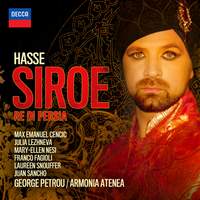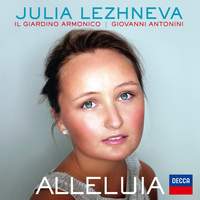Interview,
Julia Lezhneva sings Carl Heinrich Graun
 Still in the first decade of her career, the young Russian soprano Julia Lezhneva has already proved herself a compelling ambassador for numerous baroque treasures which have been undeservedly neglected by posterity – her crystal-clear coloratura and the infectious joie de vivre of her singing played no small part in the recent successful revival of Johann Adolf Hasse’s Il Siroe and the first-ever recording of one of Porpora’s solo motets (included on her debut solo disc for Decca, Alleluia).
Still in the first decade of her career, the young Russian soprano Julia Lezhneva has already proved herself a compelling ambassador for numerous baroque treasures which have been undeservedly neglected by posterity – her crystal-clear coloratura and the infectious joie de vivre of her singing played no small part in the recent successful revival of Johann Adolf Hasse’s Il Siroe and the first-ever recording of one of Porpora’s solo motets (included on her debut solo disc for Decca, Alleluia).
For her latest solo recording (released in April on Decca), she’s turned her attention to the works of Carl Heinrich Graun (1704-59), a German who was one of the most prolific composers of Italian opera during the first half of the eighteenth century and spent two decades as Kapellmeister to Frederick the Great. Very few of Graun’s three dozen or so operas remain in the repertoire today, even in excerpt, so Lezhneva’s project has been a real labour of love for her and her long-standing piano accompanist Mikhail Antonenko (who debuts as conductor with Decca and Concerto Köln on the recording); I spoke to her over the phone recently about the research involved in bringing these scores back to life, Graun’s love-affair with the female voice, and why so much of this incredible music has fallen by the wayside…
How did you first discover Graun’s music, and how did this recording come about?
I found all the arias for this CD in the Berlin library together with Misha [Antonenko]: it started when Misha’s sister, Ekaterina Antonenko (a choir conductor in Russia and founder of Intrada vocal ensemble) advised us to consult her friend Professor Karl Wilhelm Geck from the Saxon State Library. Mr Geck informed us that nearly all the manuscripts are housed at the Berlin State Library (Staatsbibliothek zu Berlin – Preussische Kulturbesitz) and from there we got in contact with Dr Schmidt-Hensel, who is a great Hasse and Graun specialist. Dr Schmidt-Hensel was extremely kind to us and allowed us to have copies of the scores with us as well as to go through real manuscripts for many hours at the library. What an adventure - it was a miracle time!! Following a few hours with the scores, it became clear that our idea to perhaps combine Graun with some other composers of the era would be a betrayal, as Graun’s music is so strong, vivid, and emotional that it deserves at least a full CD. Even after making that decision, it was still extremely hard to choose, as we could easily have recorded two albums from the music we discovered....
Anyhow, my very first ‘meeting’ with Graun’s music was performing ‘Mi paventi il figlio indegno’ from Britannico – that was in Potsdam, in 2012. I was advised to sing this aria for an open-air gala concert, and it was a big surprise! It suited me very well, with all this incredible coloratura, and it was so very exciting to learn this piece, but then for a couple of years nothing more happened; it was only when the Hasse Siroe project with Parnassus and Max Cenčić came up, for the recording on Decca, and we decided to insert an additional aria for my character Laodice, in the last act. And that was when we looked back and thought about Graun: he and Hasse were the most influential operatic composers of that time, so this aria [‘Di tuo amor mio cor e indegno’, also from Britannico] was a great choice stylistically (and also a great choice for my character). And after the performances and recordings, Max talked to me and Misha and said ‘You need to go deeper into Graun’s music, because I’m sure there are more gems there!’. So I’m most grateful to Max, to Misha and his sister Katya, to Dr Schmidt-Hensel - and of course to Decca for letting us do it!
Hasse and Graun were both Germans writing predominantly Italian opera: do you see many stylistic similarities between the two?
Absolutely: the positioning of the voice is very similar, but Graun is really special! To me (especially after spending so much time with this music), it’s instantly recognisable – he has a very clear, particular style. Perhaps because he was a tenor himself, he understood singers so well and wrote in a very natural way. It is as if you can see the rise of Bel canto style with many of the Graun’s arias, especially the ‘adagio’ or ‘andante’ ones.
Do you think there’s any chance of seeing a complete revival of any of these operas in the near future, either in the studio or in the opera-house?
I hope so! It something we have talked about, and I think that after the success we had with Siroe it seems more possible.
Were any of these arias written for castrati?
Most of the arias on the album were written for the female voice – including five arias (from Britannico, Coriolano, Silla, Orfeo, Armida) for the main prima donna of the Friedrich court, the soprano Giovanna Astrua (1720-1757). It’s quite obvious that Graun was most attracted to the female voice - and Astrua was evidently an incredible performer. There’s a fascinating letter about her from Frederick the Great to the Margrave of Bayreuth saying ‘This singer is really surprising – she does everything a flute or violin can do, with infinite speed and agility!’.
We also have the opening track, ‘Sento una pena’ from Orfeo, written for the prima donna Giovanna Gasparini, who spent several years at the court before Astrua came there. And indeed we have three arias written for a castrato Antonio Uberti detto ‘Porporino’ (1719-1783), who was the leading singer there alongside Astrua and Gasparini. His teacher Nicola Porpora really adored Uberti, and some sources claim that Porpora actually preferred Uberti’s legato and sense of phrasing to the unbelievable possibilities of Farinelli's and Caffarelli's voices. The three arias written for Porporino are ‘La Gloria t’invita’ (from Armide) ‘Sforzero l’avverso mare’ (from Iphigenia in Aulis), and ‘D’ogni aura al mormorar’ (from L’Orfeo).
Did the manuscripts from Berlin give many clues about cadenzas and ornamentation, or was that something you had to come up with for yourself?
Yes, absolutely: I didn’t have anyone on hand to help with this other than Misha (we regularly write cadenzas together, starting from the Alleluia album). There wasn’t much evidence (or really much time!), so ultimately I had to trust my own imagination!
Why do you think Graun’s music has fallen off the radar?
Well this isn’t really my own idea, it’s the idea of a journalist from the Netherlands with whom I talked recently (and I’m going to borrow it because he put it so perfectly!): it’s partly because it’s in Italian! Because Graun was working really closely with Frederick II, there was this strong impetus to do things in Italian and for the very closed society of the royal court. (Misha also adds that opera at that period was still not the ‘people’'s genre and, more importantly, not yet concerned with representing local countries' traditions and history. And then it makes sense – it’s like what happened with Glinka in Russia! There were all these wonderful Italian composers who worked in Russia (mainly in St. Petersburg, for the Tsarina’s courts) before Glinka, and they wrote all this amazing music, but because it was in Italian it never really became part of our heritage. But then when Glinka turned up - a Russian who’d grown up in Russia, but returned with the benefit of an Italian education and background - you get Ruslan and Ludmila (in Russian), which was a total revelation! There are perhaps similarities with Wagner in Germany and it's totally understandable, yet it is so great to have a chance for Graun and generally to find out more about the huge heritage of baroque, galante and rococo styles – with its operatic tradition based mainly on Italian language and Italian influence.
'Mikhail Antonenko and his energetic Concerto Köln set mercilessly swift tempos throughout...Lezhneva despatches barrages of notes as fluently as if she were sitting picking them out on the piano...Yet she’s expressive throughout.' (The Guardian)
Available Formats: MP3, FLAC, Hi-Res FLAC
Recent and related recordings from Julia Lezhneva
(Her complete available discography is listed here.)
Hasse: Il Siroe Re di Persia
Max Emanuel Cencic, Franco Fagioli, Julia Lezhneva, Juan Sancho, Mary-Ellen Nesi, Laureen Snouffer; Armonia Atenea, George Petrou
'The cast seems unfazed by the technical challenges...the soprano Julia Lezhneva shows that it is possible to negotiate Hasse’s vocal writing with stylishness and beauty of tone as well as accuracy.' (The Guardian)
Available Formats: MP3, FLAC, Hi-Res FLAC
'Lezhneva’s bell-like soprano is one of the most exciting emerging voices around, and she doesn’t disappoint in this recital of early Handel. Surely no instrumentalist’s fingers can move faster than Lezhneva’s vocal cords.' (The Guardian)
Available Formats: MP3, FLAC
'A singer of uncommon ability and vivacity...Il Giardino Armonico provide apt support throughout: their dashing, frothy strings offer a syllabub-light bed for her glass-like clarity and poise.' (The Independent)
Available Formats: MP3, FLAC, Hi-Res FLAC






